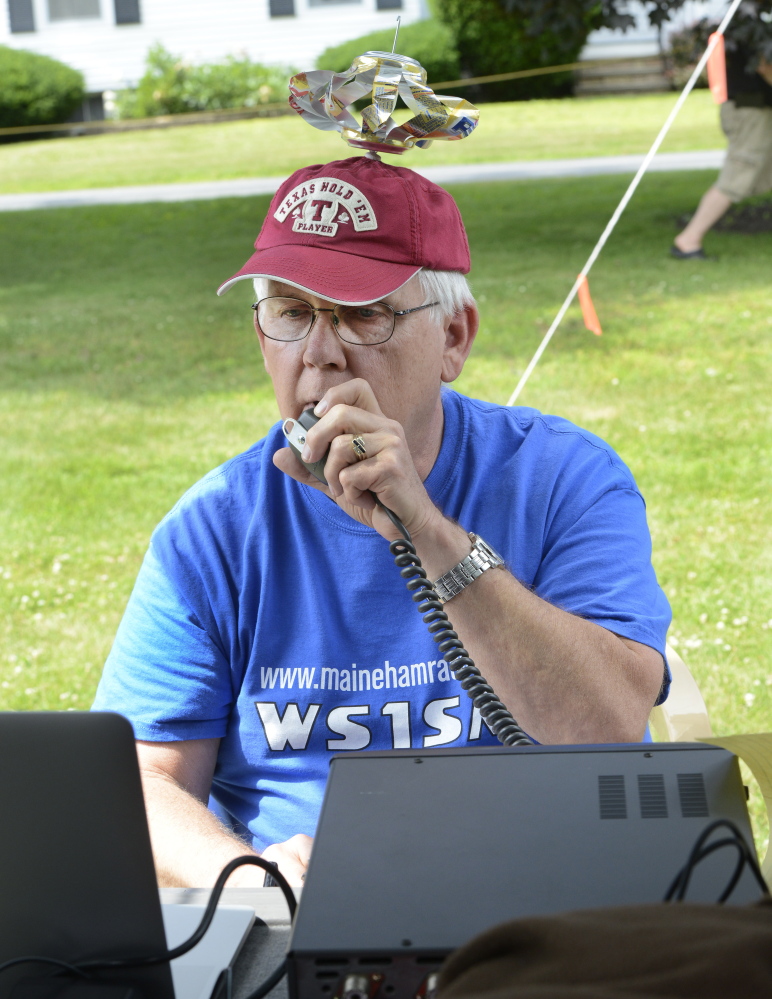SCARBOROUGH — While other people were paddling, swimming and biking over the weekend, some dedicated hams were huddled over their radios for a marathon test of emergency communication skills.
They were among tens of thousands of amateur radio operators across the country who set up their radio and antenna arrays in a race to communicate with as many other operators as possible between 2 p.m. Saturday and 2 p.m. Sunday.
That explains why a lot of strange-looking antennas cropped up and odd-sounding squeaks and crackles emanated from the Wireless Society of Southern Maine campsite at the Wassamki Springs campground in Scarborough, where members took part in Field Day, an annual emergency preparedness exercise sponsored by the American Radio Relay League.
Many of the group’s 68 members spent Saturday night testing their skills and explaining their passion for ham radio to anyone who ventured into their midst.
“When all else fails, we are there,” said Thom Watson of Gorham.
Ham radio operators, who must pass an exam, are licensed by the Federal Communications Commission and are not allowed to use their skills for monetary gain, unlike commercial radio station operators. Hams provide emergency communications during hurricanes, earthquakes, wildfires, floods, blackouts and other disasters when more complex communication systems fail or overload.
The National Weather Service relies on ham radio operators for reports of conditions during storms and other weather events. They kept communications flowing between emergency management agencies during the terrorist attacks of Sept. 11, 2001.
“A lot of times when communications networks are shut down, we are called in to fill gaps,” Watson said.
About 30,000 of the 690,000 ham radio operators across the U.S. took part in Field Day, which is billed as the single largest emergency preparedness exercise in the country. There are about 4,000 hams in Maine and 2 million around the globe.
Members with the Wireless Society of Southern Maine range in age from 10 to 92.
Field Day participants said the exercise is both exhausting and exhilarating as they race to connect with other hams.
“It turns into a contest,” said Frank Allen of Waterboro.
Hams all have their niche interests, Allen said. Some communicate solely by Morse code; others prefer broadcasting with the least amount of power possible. There are hams who use solar power and others who communicate digitally.
Hams normally like to chitchat with other hams.
“I have had three-hour conversations with a guy who farms in Pennsylvania. You talk about anything, except sex, religion or politics,” Allen said.
Like many other amateur radio operators, Joe Blinick, 74, of Falmouth, a ham operator since age 14, has traveled to other countries to meet in person some of the hams he has conversed with.
But on Saturday, the hams spent only a few seconds in contact, enough time to exchange call signals, as they competed to earn points for making various types of contacts. Frank Krizan of Garland, Texas, who spends his summers at the Scarborough campground, managed to contact the International Space Station.
Krizan said normally the astronauts will talk to him for 10 to 15 minutes, but on Saturday they were besieged with hams trying to make contact.
Cindy Shepard of Westbrook, president of the Wireless Society of Southern Maine, said her group welcomes new members, who don’t have to be licensed, just interested. Shepard said her husband got involved in ham radio first and then got her interested.
“I was watching him have all the fun,” she said.
Send questions/comments to the editors.




Success. Please wait for the page to reload. If the page does not reload within 5 seconds, please refresh the page.
Enter your email and password to access comments.
Hi, to comment on stories you must . This profile is in addition to your subscription and website login.
Already have a commenting profile? .
Invalid username/password.
Please check your email to confirm and complete your registration.
Only subscribers are eligible to post comments. Please subscribe or login first for digital access. Here’s why.
Use the form below to reset your password. When you've submitted your account email, we will send an email with a reset code.